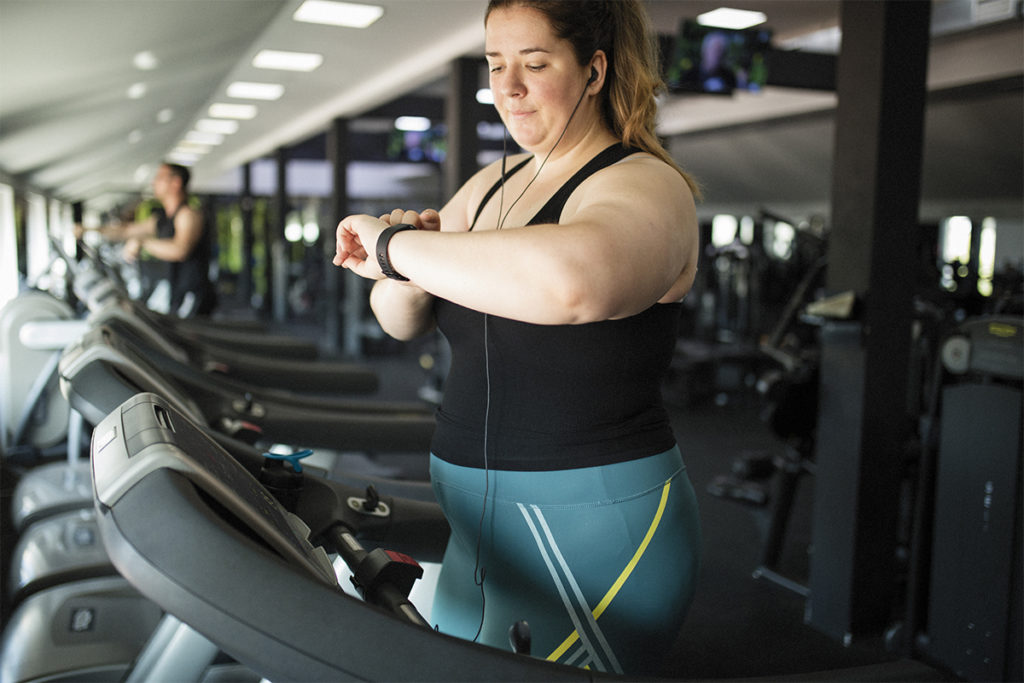Muscle Activity and Body Position
Do slight changes in body position affect muscle activity?
One day, while I was doing squats in the gym and listening to my iPod, a bodybuilder friend approached me with some advice. “Jason,” she interrupted, “if you want to target the inside of your quads, use a wide stance and point your toes out like a duck. If you want to target the outside of your quads, use a narrow stance and point your toes in like a pigeon.” I decided to give it a try since, after all, bodybuilders should know how to target different muscles. But I also started to wonder whether changing body position really changes the focus of the exercise.
The only way to truly know which muscles are used is to measure their electrical activity with an electromyogram (EMG), the skeletal muscle equivalent of an electrocardiogram for your heart. Well, guess what? Scientists have done just that. And some of what they have found may surprise you. Let’s take a look at how different body positions affect muscle activity during some common weight training exercises.
Leg Extensions and Squats
Comparing three leg positions (medially rotated, laterally rotated and neutral) during a set of 8 repetitions of leg extensions on a leg extension machine, Stoutenberg et al. (2005) found that medially rotating the legs by pointing the toes inward targeted the vastus lateralis and vastus medialis muscles, whereas laterally rotating the legs by pointing the toes outward increased rectus femoris activity. Using isometric contractions on an isokinetic leg extension machine (a machine on which you can do isometric contractions against a nonmoving leg pad) at three knee joint angles (90, 150 and 175 degrees), Signorile et al. (1995) found that when the legs were held almost straight (175 degrees), a position often used to stabilize the knee joint during the early stages of rehabilitation, medially rotating the legs produced the greatest quadriceps activity. However, these researchers suggested that in the later stages of rehab, a neutral foot position at a 90-degree angle might provide the most effective condition for rehabilitation following knee injury, since this angle and foot position caused the greatest amount of quadriceps muscle activation.
For squats, Boyden, Kingman & Dyson (2000) found that changing leg position by pointing the toes in, out or straight had no effect on quadriceps activity (I guess my bodybuilder friend was wrong). McCaw and Melrose (1999) found that stance width did not affect quadriceps activity either but did influence adductor longus and gluteus maximus activity, with a wide stance (140% of shoulder width) eliciting greater activity in these two muscles than a shoulder width or narrow (75% of shoulder width) stance. Comparing partial, parallel and full squat depths, Caterisano et al. (2002) found that the gluteus maximus, but not the vastus lateralis, vastus medialis or biceps femoris, became more active as squat depth increased.
Lat Pull-Downs and
Seated Rows
Signorile, Zink & Szwed (2002) found that a wide grip during frontal lat pull-downs using a cable lat pull-down machine while seated increased latissimus dorsi and triceps activity whereas a close grip increased pectoralis major and posterior deltoid activity. In contrast, Lehman et al. (2004) found that a wide grip did not increase latissimus dorsi activity, nor did a close grip (with palms facing in) preferentially activate the biceps, as is commonly believed. To target the upper-back muscles, seated rows seem to be better than lat pull-downs. Lehman et al. (2004) found that the trapezius, rhomboids and latissimus dorsi were all more active during seated rows than they were during lat pull-downs. These researchers also found that the common recommendation of retracting the scapulae by squeezing the shoulders together had no effect on muscle activity.
Bench Press and Push-Ups
Mainly thought of as a chest and triceps exercise, the bench press is also great for the deltoids. Clemons and Aaron (1997) found that the triceps and anterior head of the deltoid were the most active muscles during the bench press (compared with the pectoralis major and biceps). The researchers found that the widest grip tested (190% of shoulder width) elicited greater muscle activity in all four muscles than two narrower grips (shoulder width and 130% of shoulder width). For the best overall training stimulus, clients should use a grip that is almost double their shoulder width.
While push-ups may seem to be similar to a bench press (with the bench in neutral position), there appear to be differences when isolating specific muscles. Researchers found that for both exercises, the triceps were more active in a narrow hand position, whereas the pectoralis major was more active with a narrow hand position for push-ups (Cogley et al. 2005; Lehman et al. 2005) and more active with a wide grip for the bench press (Lehman 2005). Moving from a wide to a narrow grip for the bench press moved the emphasis from the pectoralis major to the triceps (Lehman 2005). Lehman et al. (2006) also found that rectus abdominis (but not external obliques) activity was greater when doing push-ups with hands (but not feet) on a stability ball compared with hands on a bench.
Abdominal Crunches
With all the abdominal training devices on the market, how can clients know which is best for their abs? The answer: you are probably best served sticking with the floor or mat. There has been enough research comparing commercial abdominal devices with traditional mat or floor crunches or sit-ups to conclude that traditional crunches are just as effective or better for eliciting abdominal muscle activity. For example, when comparing the effectiveness of commercial abdominal devices with that of traditional crunches consisting of lifting the shoulders and torso a few inches off the ground, Sternlicht et al. (2005) found that only one commercial device elicited a higher rectus abdominis activity than a traditional crunch. In all other cases, traditional crunches, including those eliciting external obliques activity, were better than or similar to commercial devices.
When your clients do crunches, tell them to lie on an unstable surface. Vera-Garcia, Grenier & McGill (2000)—using 6-second isometric contractions—and Clark, Holt & Sinyard (2003)—using 2-second dynamic contractions—found that the rectus abdominis and external obliques were more active during crunches performed on a stability ball with feet on the floor and back on the ball than they were during crunches done while lying on a stable surface. Sternlicht et al. (2007) found that abdominal muscle activity was significantly greater during stability ball crunches than during floor crunches only when the ball was placed under the lower back. Placing the ball under the upper back, below the shoulder blades, actually resulted in less abdominal activity than doing crunches on the floor.
While crunches on unstable surfaces may be better for your clients’ abs, don’t assume that other exercises on the stability ball are better for your clients’ core muscles. Lehman et al. (2005) found no difference in rectus abdominis, external/internal obliques and erector spinae activity between upper-body exercises (bench press, biceps curls, lateral raises, shoulder press, and triceps extensions) performed while sitting on a bench versus a stability ball (the bench press was performed in the supine position). Behm et al. (2005) found that while rectus abdominis and erector spinae activity was greater when a chest press was performed on a stability ball rather than a bench, there was no difference in muscle activity between stable and unstable conditions with a shoulder press.
The popular belief that certain exercises can target upper and lower portions of the rectus abdominis is also not supported by research. That is because muscles cannot contract with only part of their length. The six-pack look your clients dream of is not six separate muscles or three pairs of muscles. It’s all one muscle, with tendon inscriptions separating each “section.”
Clark, Holt & Sinyard (2003) found no difference between upper and lower rectus abdominis activity during any of the exercises they tested, but did find that upper-body exercises (traditional crunch, crunch on stability ball and ab trainer–assisted crunch) elicited greater rectus abdominis activity than lower-body exercises (reverse crunch, leg lowering). Lehman and McGill (2001) found no difference in activity between the upper and lower rectus abdominis for either the traditional crunch or the straight leg raise. Willett et al. (2001) found that the traditional crunch, twist crunch (rotation of the spine while lifting torso), reverse crunch (raising legs and buttocks instead of torso) and V-sit (raising both torso and legs to create a “V” shape) all produced similar levels of upper rectus abdominis activity. These researchers did find that the lower rectus abdominis was more active during the reverse crunch and the V-sit—as were the external obliques, which goes against the popular belief that twisting movements target the obliques.
While a couple of other studies have also shown differences in activation between upper and lower portions of the rectus abdominis, they did not express the EMG signal as a percentage of the muscle’s maximum activity, precluding valid comparisons between the two portions of the muscle.
The next time you are training clients, use these research findings to help you decide which positions and grips are best. Not only will your clients maximize their workouts, but they won’t get interrupted while listening to music on their iPods.
To maximize how much clients’ muscles are working when lifting weights, follow these guidelines:
Quadriceps
Recommend squats. Given the multijoint movement of the quadriceps muscles, squats are the best exercise for them. Tell your clients to use whatever leg position, stance width and squat depth are right for their bodies, since all are equally effective.
Gluteus Maximus
Again, have your clients do squats. Tell them to use a wide stance and to squat until their thighs are past being parallel to the floor. (The study that yielded this recommendation did not address knee safety and angle. Always take clients’ safety into account.)
Chest
Bench press: advise clients to use a grip nearly double their shoulder width. Push-up: suggest a narrow hand position with hands together under the center of the sternum, forming a diamond shape between thumbs and index fingers.
Upper Back
Recommend the seated row machine. All the major muscles of the upper back—trapezius, rhomboids and latissimus dorsi—are more active during seated rows.
Abdominals
Have your clients do crunches on a stability ball with the lower back on the ball and the upper body lifted off the ball.
References
Boyden, G., Kingman, J., & Dyson, R. 2000. A comparison of quadriceps electromyographic activity with the position of the foot during the parallel squat. The Journal of Strength and Conditioning Research, 14 (4), 379–82.
Caterisano, A., et al. 2002. The effect of back squat depth on the EMG activity of 4 superficial hip and thigh muscles. The Journal of Strength and Conditioning Research, 16 (3), 428–32.
Clark, K.M., Holt, L.E., & Sinyard, J. 2003. Electromyographic comparison of the upper and lower rectus abdominis during abdominal exercises. The Journal of Strength and Conditioning Research, 17 (3), 475–83.
Clemons, J.M., & Aaron, C. 1997. Effect of grip width on the myoelectric activity of the prime movers in the bench press. The Journal of Strength and Conditioning Research, 11 (2), 82–87.
Cogley, R.M., et al. 2005. Comparison of muscle activation using various hand positions during the push-up exercise. The Journal of Strength and Conditioning Research, 19 (3), 628–33.
Lehman, G.J. & McGill, S.M. 2001. Quantification of the differences in electromyographic activity magnitude between the upper and lower portions of the rectus abdominis muscle during selected trunk exercises. Physical Therapy, 81 (5), 1096–1101.
Lehman, G.J. 2005. The influence of grip width and forearm pronation/supination on upper-body myoelectric activity during the flat bench press. The Journal of Strength and Conditioning Research, 19 (3), 587–91.
Lehman, G.J., et al. 2004. Variations in muscle activation levels during traditional latissimus dorsi weight training exercises: An experimental study. Dynamic Medicine, 3, 4.
Lehman, G.J., et al. 2005. Replacing a Swiss ball for an exercise bench causes variable changes in trunk muscle activity during upper limb strength exercises. Dynamic Medicine, 4, 6.
Lehman, G.J., et al. 2006. Shoulder muscle EMG activity during push up variations on and off a Swiss ball. Dynamic Medicine, 5, 7.
McCaw, S.T., & Melrose, D.R. 1999. Stance width and bar load effects on leg muscle activity during the parallel squat. Medicine & Science in Sports & Exercise, 31 (3), 428–36.
Signorile, J.F., et al. 1995. The effect of knee and foot position on the electromyographical activity of the superficial quadriceps. Journal of Orthopedic & Sports Physical Therapy, 22 (1), 2–9.
Signorile, J.F., Zink, A.J., & Szwed, S.P. 2002. A comparative electromyographical investigation of muscle utilization patterns using various hand positions during the lat pull-down. The Journal of Strength and Conditioning Research, 16 (4), 539–46.
Sternlicht, E., et al. 2005. Electromyographical analysis and comparison of selected abdominal training devices with a traditional crunch. The Journal of Strength and Conditioning Research, 19 (1), 157–62.
Sternlicht, E., et al. 2007. Electromyographic comparison of a stability ball crunch with a traditional crunch. The Journal of Strength and Conditioning Research, 21 (2), 506–509.
Stoutenberg, M., et al. 2005. The impact of foot position on electromyographical activity of the superficial quadriceps muscles during leg extension. The Journal of Strength and Conditioning Research, 19 (4), 931–38.
Vera-Garcia, F.J., Grenier, S.G., & McGill, S.M. 2000. Abdominal muscle response during curl-ups on both stable and labile surfaces. Physical Therapy, 80 (6), 564–69.
Willett, G.M., et al. 2001. Relative activity of abdominal muscles during commonly prescribed strengthening exercises. The Journal of Strength and Conditioning Research, 15 (4), 480–85.
Jason Karp, PhD
A professional running coach, freelance writer, fitness consultant and PhD candidate in exercise physiology at Indiana University. He coaches runners of all levels through RunCoachJason.com.





